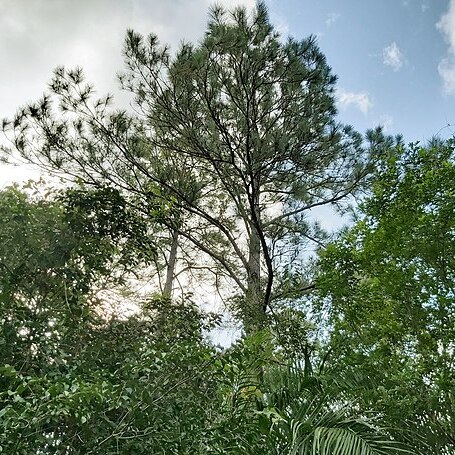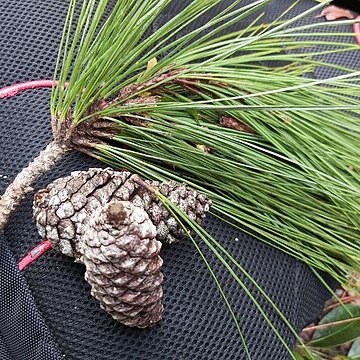Trees to 40 m tall; trunk to 1 m d.b.h. in native range; bark gray or pale reddish brown, fissured and shed in large, flat, wide plates; crown ovoid or irregularly shaped; branchlets initially green and glaucous, aging orange-brown, producing a few short nodes each year; winter buds cylindric, scales white fringed at margin. Needles (2 or)3 per bundle, usually 4 or 5 per bundle on young trees, dull green or pale yellow-green, 15-30 cm × ca. 1.5 mm, stomatal lines present on all surfaces, resin canals (2 or)3 or 4(-8), internal, base with persistent sheath 1-1.5 cm, margin serrulate. Seed cones almost terminal, ovoid-cylindric, 5-10(-12) × 3-6 cm, often leaving a few basal scales. Seed scales reflexed or spreading; apophyses lustrous, tan or reddish brown, swollen, cross keeled; umbo slightly projecting, ending in a straight, minute prickle. Seeds usually narrowly mottled gray or light brown, rhombic-ovoid, 6-7 mm; wing dull gray, 2-2.5 cm, usually remaining attached.
More
A tree. It grows 20-45 m tall. The trunk is round and slender and 50-100 cm across. The bark is rough, red brown and scaly. It cracks into irregular square plates. The leaves are needle-like and 15-26 cm long by 14-18 mm wide. They are slightly twisted and saw-toothed. The male cones are 5-6 cm cm across. The female are oval and 5-12 cm long by 4-6 cm wide when open. The seeds are light brown and 5-7 mm long by 3-4 cm wide. They are winged.
Hillsides and plains at low elevations from sea level to 600 metres. Found in a wide range of forest and savannah habitats, often as a pioneer species, for instance after fires, where it can create pure stands.
More
It is a tropical plant. It grows in woodland between sea level and 800 m above sea level.



